‘Here is the land which centuries have left unmarked. From the dawn of time it has remained green and bare and time has been estimated here by thousands of years. In the hourglass of our world even the centuries are just dust specks. […] And even then, the following years will change this place more than the previous eternity.’ This is how our second president Lennart Meri described Siberia in his travel book ‘Shipmates on the Green Ocean’. On a four storied cargo boat Maria Fernanda II, while travelling slowly up the Amazon river and lazily gazing over the impenetrable jungle, I suddenly realised that the same observation is true for this part of the world.
I clearly remember when on the first week of discovering South-America, a Dutch girl mentioned that it is possible to travel from Colombia to Peru on the Amazon river. A three-day ride on a slow cargo boat from Leticia to Iquitos, this sounded like an unforgettable adventure. I stored it somewhere in my memory so on the right time I would remember it. An opportunity to discover one of the few remaining truly wild places and spend time on the largest river in the world – this created such a strong image in my mind that it was difficult to forget. The stories that I heard and read later about awful living conditions, terrible food, dangerous passengers, and soul crushing boredom functioned as a challenge to prove the opposite.
Leticia, the southern-most city of Colombia was a threshold to the jungle for me and my friend Ants-Erik. Here, where the untamed nature has forcibly retreated from human activity, is the meeting spot of three countries. Tres Fronteras (three frontiers), simultaneously a part of Colombia, Brazil, and Peru. Leticia, Tabatinga, and Santa Rosa reflectively, hold on to their differences, but the constant flux of people, goods, and money creates an unusual symbiosis. Leticia and Tabatinga are next to each other. I would no be surprised if first time travellers there would consider them the same city. However, speeding over the border with your rickshaw the difference is noticeable immediately. The names and language on the streets change, Spanish is substituted with Portuguese. When paying for things or services you have to use reals. If you don’t have the local currency, then you can still pay in pesos or soles. It is advisable to do some quick calculations not to get ripped off by the locals too much. But at the same time, you can make it all up later. Go to the exchange point and depending on the day the rate can be in your favor. Avoid the early mornings or late afternoons when local people go to change their cash, because the rates are a bit higher.
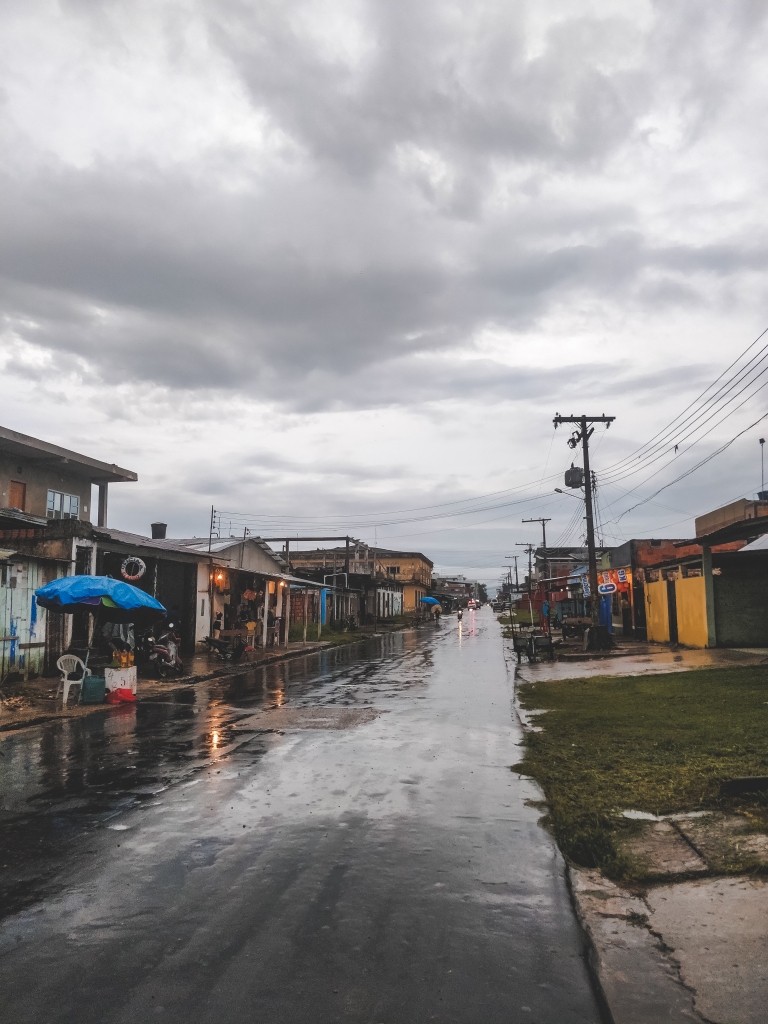
Opposite Leticia and Tabatinga, on the other side of the river sits Santa Rosa. This one street village feels like a strange counterpart for hectic Brazil and Colombia. Here you can see typical Amazonian houses, constructed from the material found in the forest and raised several meters above the ground. In Santa Rosa there are couple of restaurants, dozen houses and a migration office where you can get your entry stamp. Within half an hour you can visit all three countries and you won’t be bothered about your documents. These you have to sort out before getting on the ship. Although we got everything done in Leticia airport and Santa Rosa migration office, there is also a possibility to visit a small shack in the middle of Amazon river. Between Leticia and Santa Rosa is a tiny hut where you can get stamps for both countries. People here do not seem to turn too much attention how the government offices look like. Here you have more pressing problems than appearances, like drug or exotic animal trafficking.
The preparations took couple of days. First of all, we had to get some hammocks, because the cabins were expensive, dark, stuffed, and full of roaches. In my mind I had pictured that we were going to sleep in hammocks on the top deck anyway. Enjoying beautiful vistas and soft wind that exiled jungle heat. Additionally, we had to buy food and water. We knew that on the boat the water was undrinkable, because it came from the river and although we were supposed to get three meals per day, we expected that for 70 soles (19 euros) for a ticket, the food is not going to be of high quality and there is not going to be much of it. So we stocked up on cans, dry food, fresh fruit, and two bottles of rum that were supposed to keep the cool jungle nights at bay and make it easier to meet the locals. In Leticia we were joined by a friendly and smiling German Jan-Kai. The more, the merrier.
The long-awaited day was finally here. Full backpacks ready and water canisters in the hand, we set out from Leticia towards Santa Rosa on a small wooden canoe. We did not have any problems crossing the river before but this time it was a different story. As soon as we stepped on the canoe and set our gear down, the boat started leaking. It’s not a big problem in itself, since most of the boats here had seen better days and really needed a fixing hand. However, half way over the river the driver realised that there was more water coming in than he could chug out with his small bucket. After a short discussion he asked us to change out positions to distribute the weight better. As soon as we stood up, we realised that there is a bigger chance to end up in the river with all our stuff. We insisted that he would squeeze everything out of the tiny engine and hoped that we will get to the cargo boat before our canoe ends up in the depths of Amazon river. Getting there dry was already out of the question.
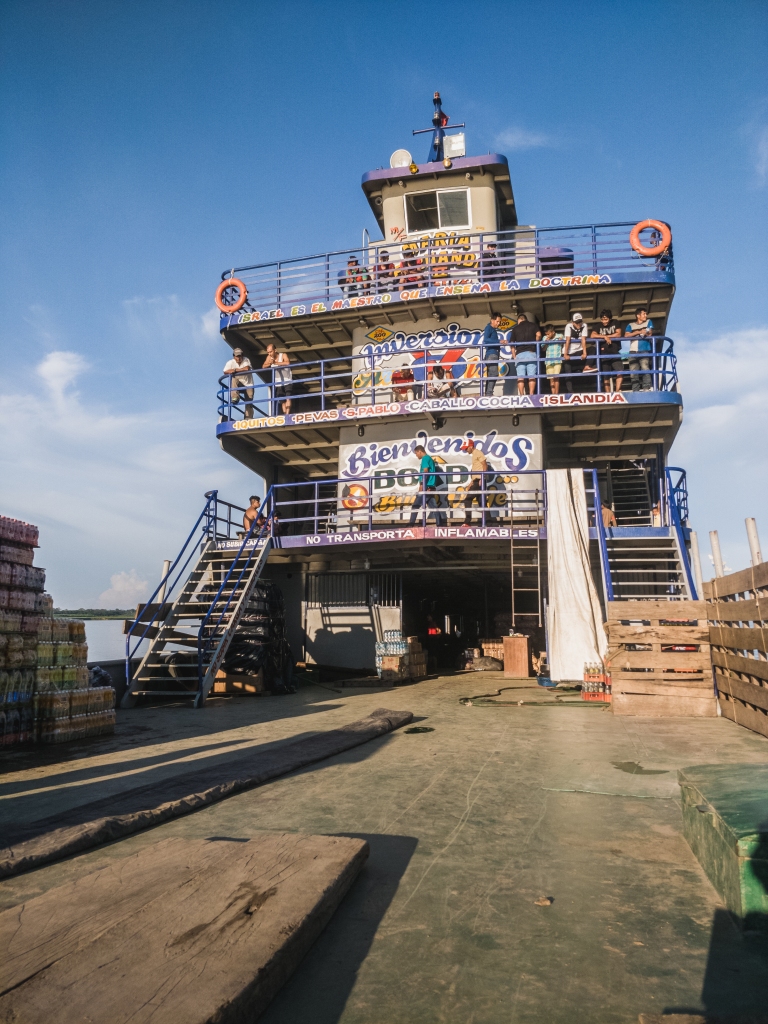
Maria Fernanda II was the glory of Amazon river several decades ago, but now there remained just a sad shadow of its former self. Unhealthy looking rust spots were peeking out under the peeling grey paint and the coverless window holes on the side gave the vessel a monstrous skeletal look. But the colourful name and words of greeting painted on the front of the ship with a smiling captain who rocked a massive belly as proper for any self-respecting chief dissolved our first concerns. With sun shining down we climbed the narrow stairs to the top deck and made ourselves comfortable in the back corner. The floor was covered with a thin plastic tarp that was supposed to protect us from the sun and the rain. Lower floors were more spacious but at the same time the windows let only a small amount of light through. There was no wind here as well, so we guessed that during the hot days lower floors will be very stuffy.
Hammocks up and overboiled rice with chicken in the belly we had nothing else to do than to wait for the departure. The lowest deck was slowly filling up with different cargo. Next to the large vegetable nets grew cement bag towers, in the middle of the floor there were columns of beer crates that were surrounded by heavy machinery, wood, cattle, and everything that is needed to survive in the jungle. All the floors above were occupied by the passengers.
People have managed to turn even the furthest parts of Amazon rainforest into homes. During three days of travel over several hundred people came and went between smaller villages up and down the river. All of them were surprised and amused by the three gringos in the corner of the top deck. For our surprise, there were not that many people on the same deck with us on the first night. One elderly man staying there was called Juan. He used to be a poacher and his speciality was exotic jungle animals. He gave that life up many years ago and was now working as a fisherman and transporting aquarium cleaning fish from Leticia to Iquitos. This was a safer job and had a steadier income than hiding jaguars or monkeys on small planes.
Darkness flowed over the forest and the river. Suddenly a great jolt went through the boat signalling that the engines had been turned on. The water behind the boat turned white and foamy, our departure from the coast was accompanied by a loud air horn. The first night was wild. Without realizing it at that moment, we had ended up in the middle of three tropic thunder storms. I was woken up by lightning that was striking every couple of seconds all around us. The storm filled our whole world. The sound of heavy raindrops against the ship and the tarp combined with thunder, the noise was deafening. After every lightning strike the world was divided into two: a blindingly bright sky and tar black forest that were separated by a jagged treeline. Without realizing it during the day, we had chosen a perfect spot where to hang our hammocks. It was the only place without any holes in the tarp. Everyone else was running around the whole night trying to find a drier spot.
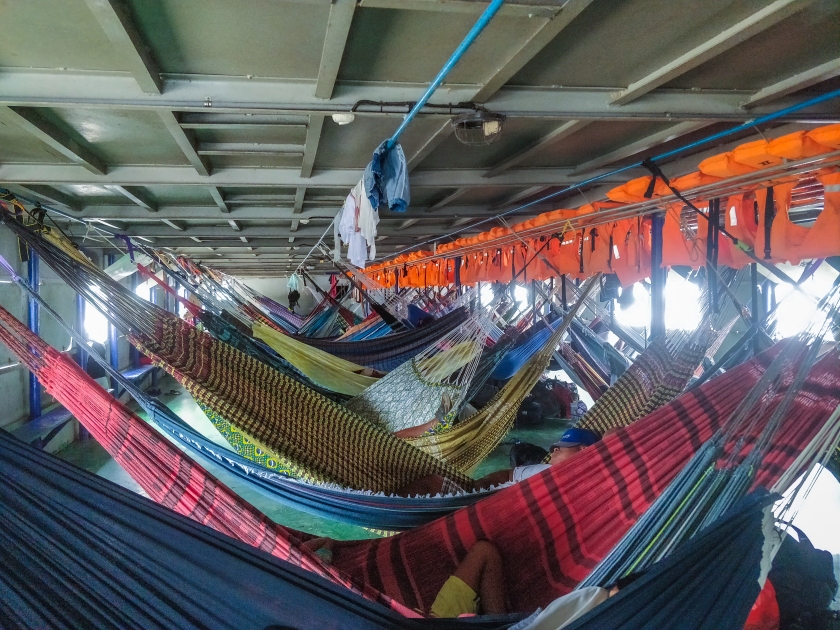
The life aboard started early, before the sunrise. We had ceremonially slept through our first stop. When we woke up the boat was already on its way again. The cargo was carried to the land and the new brought on board quickly. Next to the smaller villages, where the boat did not land, there people had to get into a motorboat tied to the big ship and that was taking them to the shore. The first time we stepped off Maria Fernanda was in Chimbote. This small mud street village was very similar to all the other ones that we came across. Small and big houses were raised or had a construction for floating underneath them. During the rainy or flooding season the river raises more than 8 metres and everything gets swept underneath it. This is the time when only mode of transportation is canoes. Life in the village looked simple. We were followed by children, dodging chickens, and cheerful ladies were shouting after us that we should definitely get something on the road from their store. Men were playing dominoes and smoking strong jungle tobacco. When we got back on the boat, we discovered that there were several armed army guys next to our things. The intimidating look and alarming feeling disappeared with a welcoming smile. It was just a passport control. After checking our documents and asking some questions about Estonia, they wished us happy travels and went their way.
The days were truly tropical: hot and humid. The cool wind blowing through the fourth floor brought some relief, but sometimes the heat was so bludgeoning that we were just lying in our hammocks for hours. The river that was several kilometers wide in some places flowed on lazily. However, eroded shores, trees that fell in the river, and more than ten meter tall trunks that floated by us told the story of Amazons hidden strength. The best view over the surrounding area was from the top of captain’s bridge. In the beginning, the plan was to sneak on top of it, but after a short discussion we opted to ask permission. Captain said that of course we can go, but we just have to be careful not to fall down. An honest request that expects person to be responsible for themselves and something that I feel has been lost in our overprotective society. From the top of the boat, the vista was incredible. The land floated silently past us and next to us towered green walls. Some of the trees were over twenty meters and housed many jungle animals. We just spotted couple of birds and several monkeys. I briefly spotted a small caiman before it dived into the depths of the river after being scared by the noise of the engines. Wildlife and being close to the shore brought other people on the deck as well. The is something calming and uniting in the wild and majestic landscapes. When the boat reached the next village we were lucky enough to see two river dolphins catching fish and swimming around us.
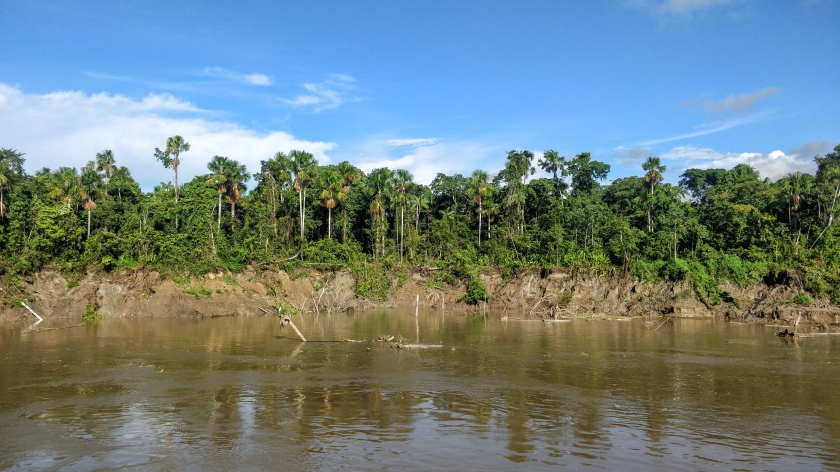
The rest of the day was filled with various activities. Sleeping in hammocks, playing cards, reading books, writing, socializing with locals, and exploring villages with difficult names. The evenings passed with a rum bottle. When on the first night there were just couple of people with us on the top deck, then second night was different. During the day the place had gradually filled up and now there were over fifty people here. Someone had taken a flat screen TV with them and most of the people were watching 2004 movie Troy. Next to us was a young couple. Looking at the way their parents were talking while the youngsters were fooling around in the hammock, we presumed that they had just gotten married or were about to very soon. The boat was so full that some people did not have room to set up their hammocks, so they had to sleep on the cold metal floor.
The beginning of the second night was clear. The crescent moon and bright Jupiter next to it lighted our way. The moment when all the lights on the boat were turned off and there was not artificial light around us for hundreds of kilometers, the sky lit up. Above our heads Milky Way was shining bright and with its countless stars reflected the number of animals in the jungle that were letting themselves be heard and filling the night silence with fantastic and unfamiliar sounds. In the distance lightning started flashing again and we were sure that the beauty of the night will not last and soon we will be engulfed in the storm again.
Fortunately, everyone remained dry. The third day started by someone shoving a sandwich in my face in hopes that I will wake up because of the smell. I did. But the food onboard was mediocre to say the least. All the meals consisted of chicken, rice, beans, and platanos. The food went down with couple of bites and we were very glad that we packed some food with us. There was a small shop on the boat as well. There you could get some cold drinks and sweets. As I was passing the kitchen I remembered a saying: “The best tasting food is the one you don’t see how it’s made.” The kitchen looked crazy, all the sanitary and hygienic precautions were non-existent, but hey we were in the middle of Amazon. There was no one to complain to and no one cares.
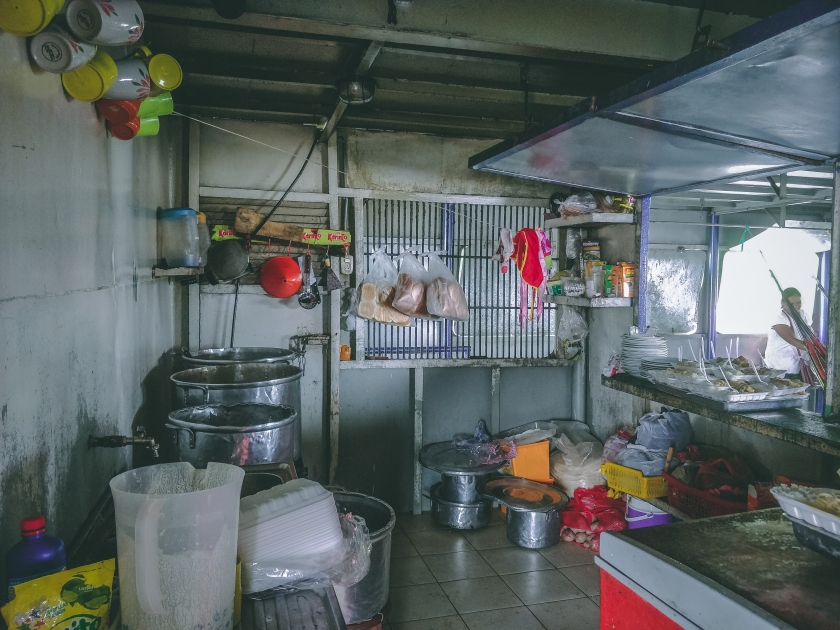
Nobody also gave a damn about the trash and where it goes. This was one of the saddest aspects of Amazon river, how dirty it was. All the trash that was created was just chucked overboard. The bin might have been next to the person, but it might have been invisible. Plastic bottles, single use plastics, wrapping paper, organic trash, everything ended up in the river. One of the saddest sights was the dolphins who were fishing and then someone throwing several nearly empty washing powder bags in the river. After that a worker emptied the whole trash bin overboard. Juan did some explaining. There is no education or information here about this type of harmful behavior. There is no information about pollution and its impact on wildlife or nature. Children see their parents doing it and they act the same. Trash is not sorted here and the environmental control not the government reach so deep in the jungle. In addition, it is difficult to think about environmental issues when you have more pressing problems, like how to find a job or support your family.
As we were approaching Iquitos and packing our things, we felt the wind rise and saw the gathering clouds. The sky turned dark blue around the horizon. The roof flapped in the wind and the idea of getting to Iquitos before rain disappeared. In the harbor it was already pouring down. As the boat pulled closer to the shore we found out to our surprise that there were no free spaces left. So, the captain had to put all of his skills into use. And he did. As a maestro conducting, he maneuvered the boat between two ships and pressed them aside with the nose of the boat. Several dents later we touched the shore and stepped to the ground. We were greeted by a lot of rickshaw drivers, epic downpour, low lights, and strong scents. We had arrived to Iquitos.
Amazon rain forest is really in the middle of a flux of change. The green body that has stayed unchanged for millennia must in next years find a way to adapt to change and survive. The protection of this precious environment is not only the responsibility of the people living there, but on us all, even on the other side of the world.

„Siin on maa, millele sajandid pole jätnud jälgi. Ajaloo koidikust saadik oli ta roheline ja tühi ning aega on siin arvestatud tuhandete aastate kaupa. […] Maailma liivakellas on sajandidki tolmukübemed. Ja ometi muutuvad lähemad aastad seda kanti rohkem kui kogu eelnev igavik.“ Nii kirjeldas Lennart Meri Siberi taigat reisiloos „Laevapoisid rohelisel ookeanil“. Nelja korruselise kaubalaeva Maria Fernanda II pardal mööda Amazonase jõge ülesvoolu sõites ja ümbritsevat läbimatut džunglit laisalt jälgides tabasin ennast mõttelt, et sarnane tähelepanek on täpne ka selle maailmajao kohta.
Mäletan selgelt, esimesel nädalal Lõuna-Ameerikat avastades mainis üks hollandlanna, et Columbiast Peruusse saab ka mööda Amazonase jõge. Kolmepäevane sõit kaubalaeval Leticiast (Kolumbia) Iquitosesse (Peruu) kõlas nagu unustamatu seiklus. Märkisin selle mälusoppi üles, kuniks tuleb õige aeg see meelde tuletada. Unistus avastada ühte vähest tõeliselt metsikut keskkonda ning lüüa surnuks aega maailma veerohkemal jõel kutsus esile liiga tugeva kujutuspildi, et sellisest võimalusest lahti lasta. Hiljem kuuldud kohutavad lood laeva elamistingimustest, söögist, ohtlikest reisijatest ning rusuvast igavusest osutusid väljakutseks vastupidist tõestada.
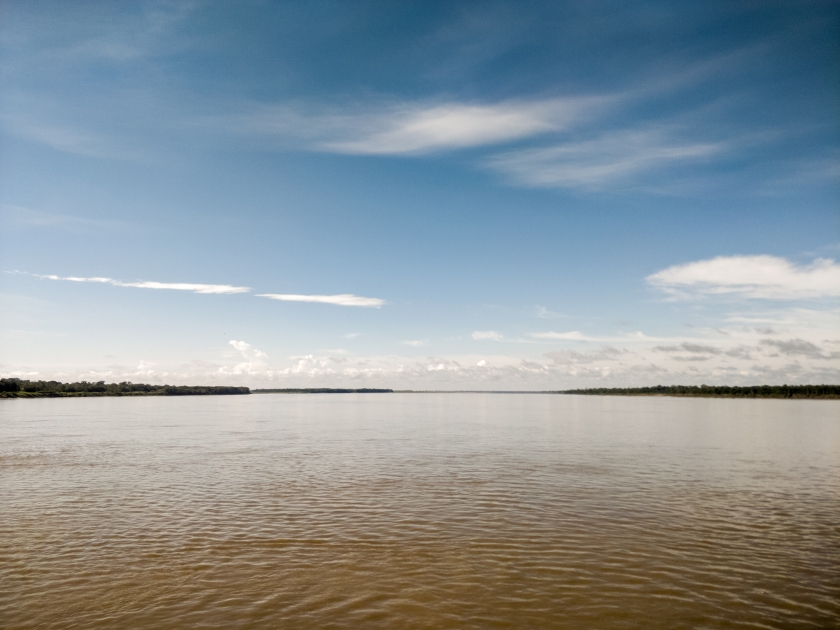
Leticia, Kolumbia lõunapoolseim linn oli minu ja sõbra Ants-Eriku jaoks kui lävi maailma suurimasse vihmametsa. Siin, kus taltsutamata loodus on taandunud inimtegevuse ees kohtuvad kolm riiki. Tres Fronteras (kolm piiri) on Kolumbia, Brasiilia ja Peruu kohtumispunkt. Leticia, Tabatinga ja Santa Rosa hoiavad kinni oma eripäradest, kuid inimeste, kauba ja raha vool loob ebatavalise sümbioosi. Leticia ja Tabatinga asuvad üksteise kõrval ning neid võiks ekslikult pidada üheks linnaks. Kihutades rikšaga (siin nimetatakse neid motocarrodeks) üle piiri on erinevus aga kohe selge. Leticiast tulles asendub tänavapildis loetav hispaania keel portugali keelega ja hiljem turul makstes tuleb kasutada reaale. Kui kohalik raha puudub, võib maksta Kolumbia pesodes või Peruu solides. Peas tuleb teha kiired arvutused, et hindadega tünga ei tehtaks. Samas võib kaotatud raha hiljem vahetuspunktis tagasi teha. Olenevalt päevast ja kellaajast on kursid kolme valuuta vahel madalamad või kõrgemad. Tavaliselt tuleb tööpäeva alguses ja lõpus maksta natuke rohkem, sest siis vahetavad ka kohalikud päeva peale kogutud raha õigeks.
Leticia ja Tabatinga vastaskaldal asub Santa Rosa. See ühetänavaline küla mõjub hektilisele Brasiilia ja Kolumbia poolele kui kummaline vastand. Siin on vaid paar palkidele ehitatud maja, üksikud restoranid ja piirivalveameti kontor, kust saab passi Peruu templi. Poole tunni jooksul on võimalik kõik kolm riiki läbi sõita ning vahepeal ei taha keegi dokumente kontrollida. Need tuleb enne laevale asumist korda seada. Olgugi, et saime kõik lennujaamas ning piirivalve-kontoris joonde aetud, on tegelikult keset Amazonase jõge Leticia ja Santa Rosa vahel ka väike hütt, kus on võimalik mõlema riigi templid passi lüüa. Argielu ning piiriületamise puhul on siin suuremaid probleeme kui kontori välimus ja asukoht. Näiteks eksootiliste loomade või narkootikumide smuugeldamine.
Valmistusime sõiduks paar päeva. Enne laevale asumist tuli soetada võrkkiiged, sest kajutid olid kallid, pimedad, umbsed ja prussakatest pungil. Vaimusilmas oli nagunii plaan magada laeva ülemisel korrusel, kus avatud laevatekk pakkus vaadet ümbritsevale ning pehme tuul pagendas džunglikuumuse. Lisaks tuli varuda joogivett ning toitu. Laeval oli vesi joogiks kõlbmatu, sest see tuli otse jõest. Olgugi, et meile oli ette nähtud kolm toidukorda päevas, siis eeldasime, et 70 soli (pileti hind, umbes 19 eurot) eest ei ole toit kõige kvaliteetsem ja seda pole väga palju. Lisaks konservidele, kuivainetele ja värsketele puuviljadele soetasime ka paar väikest pudelit rummi. Need pidid soojendama jahedaid õhtuid ning lihtsustama võimaluse korral ka kohalikega tutvumist. Leticias liitus meie seltskonnaga ka saksa noormees Jan-Kai. Mida rohkem, seda lõbusam.
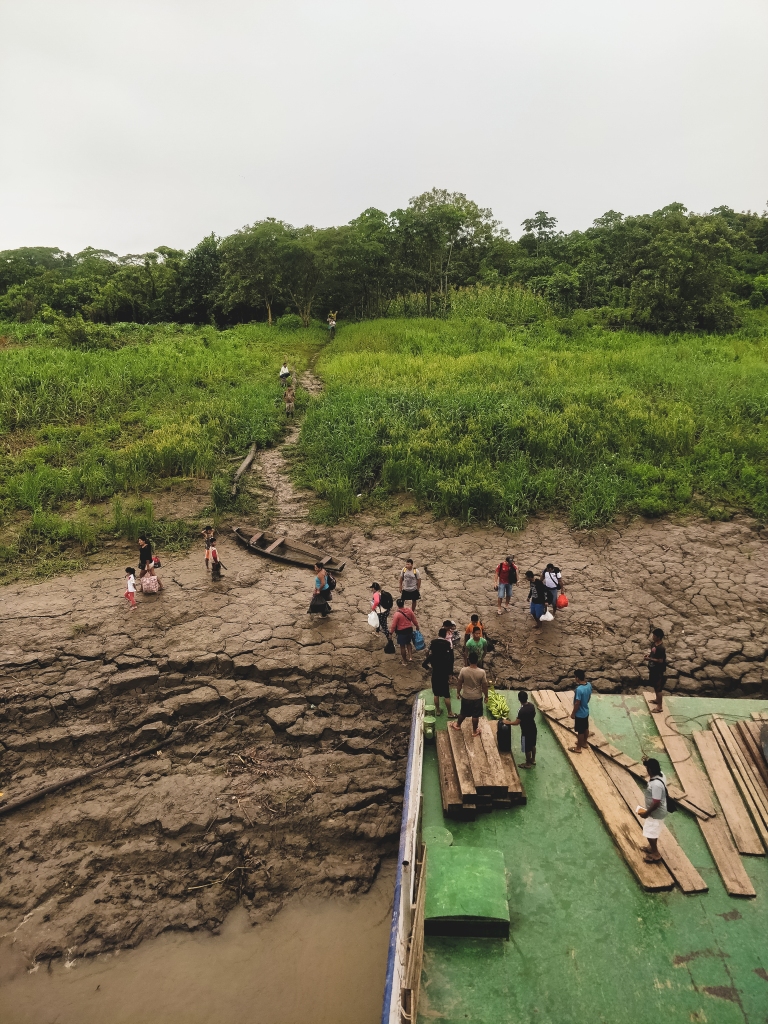
Kauaoodatud päev oli lõpuks kohal. Seljakotid pungil ja veekanistrid näpus asusime Leticiast puust kanuuga üle Amazonase Santa Rosa poole teele. Kui eelnevalt polnud jõe ületamisega probleeme, siis oli seekord lugu teine. Kohe kui varustusega kanuusse astusime hakkas see erinevatest kohtadest lekkima. Iseenesest polnud see veel suur probleem. Enamik veetaksosid olid näinud paremaid päevi ning vajasid hädasti parandavat kätt. Poolel teel üle jõe sai juht aru, et sissetulev vee hulk on suurem kui ta oma väikese ämbriga paadist välja jõuab kühveldada. Kiire arutelu tagajärjel tahtis ta meie kohad ümber vahetada, aga kohe kui püsti tõusime mõistsime, et kanuus liikudes on meil suurem tõenäosus kõikide oma asjadega jões lõpetada. Palusime juhil mootorist viimanegi välja pigistada ning lootsime, et jõuame kohale enne kui paat päris vee alla vajub. Kuivast kohalejõudmisest polnud enam mõtet rääkida.
Maria Fernanda II oli mitukümmend aastat tagasi Amazoni uhkuseks, kuid nüüd oli temast alles vaid nukker vare. Kooruva halli värvikihi alt piilusid roosteplekid, külgedel asuvad katmata aknaaugud andsid laevale tundmatu koletisliku luukere välimuse. Laevaninale kirevalt värvitud nimetus ning tervitussõnad, õigele merekarule kohaselt suure kõhuga sõbralik kapten, ning päikesepaisteline ilm lahutas korraks tekkinud kartuse. Lootust ja indu täis, kobisime mööda kitsaid treppe neljandale korrusele ja hõivasime teki tagumise nurga. Ülemist korrust kattis õhuke roheline plastikkate, mis pidi kaitsma vihma eest, kuid mida oli võimalik päeva ajal üles kerida. Alumised korrused tundusid ruumirohkemad, kuid kitsad aknad lasid vaid kadedat valgust läbi. Eeldasime, et palava ilma ja hulga inimestega muutub korrus väga umbseks.
Võrkkiiged üleval ning ülekeedetud riis koos praekanaga kõhus, ei jäänud meil muud üle kui oodata väljumist. Laeva esimene korrus täitus tasapisi erineva kaubaga. Juurvilja-võrkude kõrvale tekkisid tsemendikottide virnad, teki keskel kõrgusid õllekastid, mida ümbritsesid rasketehnika, puit, lihaloomad ja muu džunglis eluks vajalik. Ülemised korrused hõivati reisijate poolt.
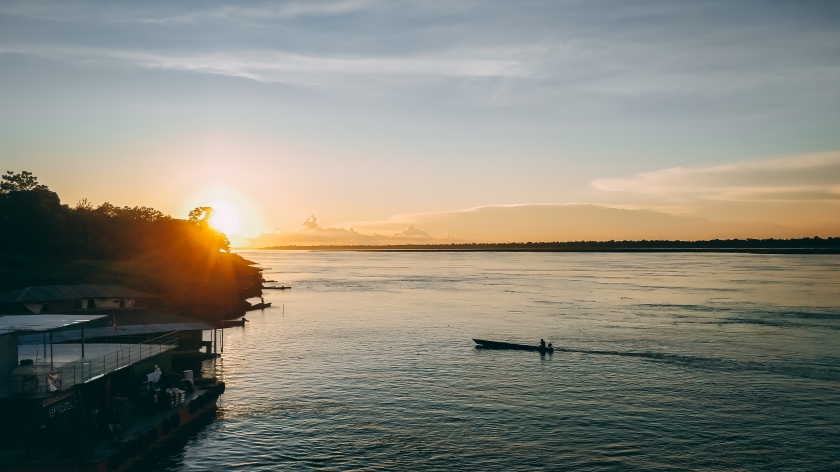
Inimesed on jõudnud ka Amazonase jõe kauged rajoonid koduseks muuta. Kolme päeva jooksul sõelus laeva ja erinevate külade vahelt sadu inimesi ja kõigile pakkus hämmingut ja nalja kolm gringot ülemise korruse tagumises nurgas. Oma suureks üllatuseks oli esimesel õhtul meie korrusel vaid paar inimest. Üheks osutus endine salakaubavedaja Juan, kelle eriala oli eksootilised džungliloomad. Nüüd teenis ta elatist kalamehena ning vedas tillukesi akvaariume puhastavaid kalu Leticiast Iquitosesse. See olevat ohutum ning kindlam sissetuleku allikas kui jaaguari või ahvide peitmine väikestesse lennukitesse.
Pimedus vajus vaikselt üle metsa. Äkitselt läbis laevakere tugev värin. Mootorid rügasid tööd teha, kaldast äratõuget saatis pidulik udupasuna hüüd. Esimene öö oli metsik. Etteaimamatult olime sattunud kolme tormi keskele. Paduvihm täitis kogu meie maailma, tugevad piisad vitsutasid laevaseinu ning kilet peade kohal. Iga tosina sekundi tagant lõi välk kuhugile kõrvale ning silmapilguks oli maailm jaotatud kaheks: pimestavalt valge taevas ja tõrvjalt must mets, mida eraldas saagjas latvade piir. Olime juhuslikult valinud ainukese koha, mille kattes polnud auke. Meie kõrval olevad reisijad rahmeldasid öö otsa ringi ning otsisid kuivemat magamiskohta.
Elu pardal algas vara, enne päikesetõusu. Olime esimese peatuse pidulikult maha maganud. Kaup laaditi kiirelt maha ja uus toodi sama ruttu peale. Väiksemate külade ääres läksid inimesed laeva külge kinnitatud mootorpaati, mis viis nad kaldale. Esimest korda astusime laevalt maha Chimbotes. See väike mudatänavatega Amazonase küla sarnanes kõikide järgnevate peatuskohtadega. Kaldaäärsed majad seisid vaiade peal, sest suurvee ajal tõusis jõgi, uskudes kohalike juttu, üle kaheksa meetri. Majade vahel oli siis võimalik sõita vaid paatidega. Külaelu tundus lihtne, meid jälitasid lapsed ja rõõmsad memmed hõikasid järele, et me just nende poekesest midagi head kaasa haaraks. Mehed mängisid doominot ja suitsetasid kanget džungli tubakat. Tagasi laevale jõudnud avastasime, et meie asjade juures seisavad relvastatud sõjaväelased. Kurjakuulutav välimus lahtus tervitava naeratusega. See oli vaid passikontroll. Dokumente nähes uuriti, kus Eesti üldse asub ning sooviti siis head reisi.
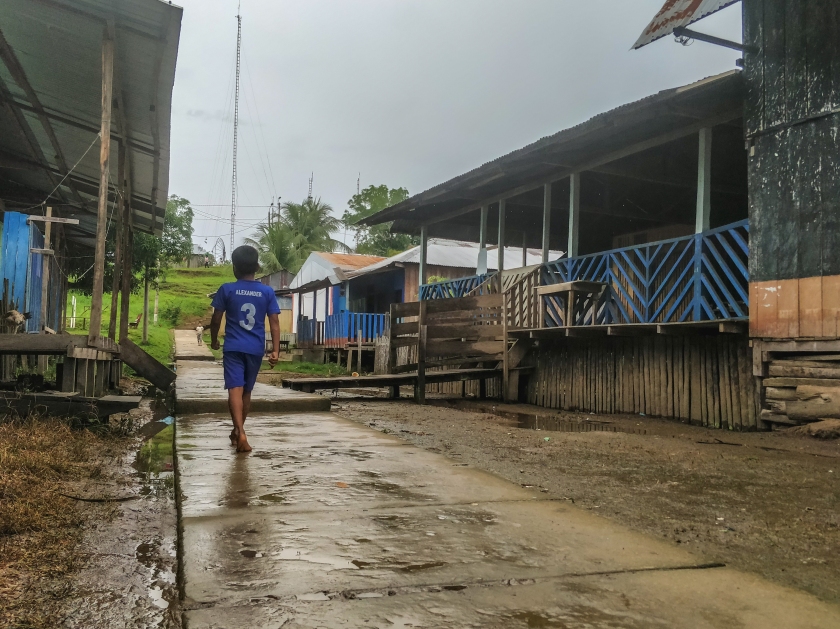
Päevad olid palavad. Neljandal korrusel puhuv tuul tõi väheke kergendust, kuid vahetevahel oli kuumus nii rusuv, et surus meid tundideks võrkkiikedesse. Kohati mitme kilomeetri laiune pruun Amazonas voolas laisalt edasi. Kaldaid ääristavad ja osaliselt vette vajunud surnud puud, ning mööda hulpivad kümnemeetrised tüved kõnelesid aga jõe varjatud jõust. Kõige parem oli ümbritsevat jälgida kaptenisilla katuselt. Esialgne plaani oli sinna peale hiilida, kuid lõpuks otsustasime siiski kaptenilt luba küsida. Tema vastus oli lihtne: „Ikka võite minna, lihtsalt ärge alla kukkuge.“ Aus palve, mis eeldab, et inimene vastutab enda eest ise, ja mis on meie vahest liiga ettevaatlikus ühiskonnas kaduma läinud. Laeva ülemiselt osalt avanes vapustav vaade. Kaldad libisesid hääletult mööda, meie kõrval kõrgus roheline sein. Metsa jälgides nägime mitmeid linde ning paari ahvi. Korraks silmasin isegi kaimanit, enne kui laevamüra ta sügavustesse ehmatas. Metsaelu tõi ka teised pardal-olijad reelingute äärde. Looduse majesteetlikkuses on midagi ühendavat ja rahustavat. Ühe küla sadamas lõbustasid meid ka kaks delfiini, kelle lõunasöögi-jahile olime peale sattunud.
Ülejäänud tunnid täitsime erinevate tegevustega. Magasime võrkkiikedes, mängisime kaarte, lugesime raamatut, kirjutasime, vestlesime kohalikega ning külastasime keeruliste nimedega asulaid. Õhtud möödusid rummipudelit jagades. Esimesel õhtul oli meil vaid paar naabrit. Päevapikku oli laev täitunud ja nüüd oli tekil üle viiekümne inimese. Keegi oli kaasa võtnud teleka ning enamik inimesi vaatas huviga 2004 aasta filmi „Trooja“. Meie kõrvale oli ennast seadnud noorpaar. Jälgides nende perekonna rõõmsaid nägusid ja juttu ajal kui nad pikalt võrkkiiges askeldasid, järeldasime, et nad on just abiellunud või seda kohe tegemas. Laev oli rahvast nii pungil, et kõigile ei jätkunud võrkkiikede jaoks ruumi ning paljud heitsid lihtsalt külmale metallpõrandale magama.
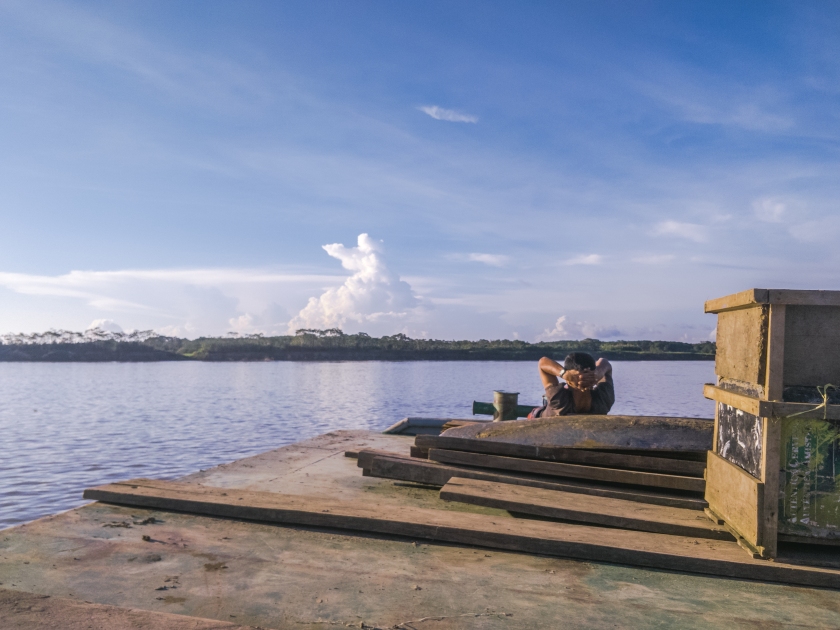
Teine öö oli selge. Sirpjas kuu näitas teed ning tema kõrval helkis selgelt Jupiter. Hetkel kui laeval lülitati välja tuled ja sadade kilomeetrite ümbruses polnud ühtki tehisliku valguse allikat, lahvatasid taevalaotuses ellu lugematud tähed. Peakohal säras Linnutee ning peegeldas oma tähtede rohkusega vihmametsas pesitsevate elusolendite hulka, kes omakorda täitsid sünkpimeda selva valju kakofooniaga. Taamal välkus tormivalgus ning olime kindlad, et vaatamata hetkelisele ilule ootab meid taaskord märg öö.
Õnneks jäid kõik kuivaks ja kolmanda päeva hommik algas sellega, et mulle suruti võisai nina ette ja loodeti, et ärkan lõhna peale üles. Toit laeval oli üsna kesine. Kõik toidukorrad koosnesid kanast, riisist, ubadest ning jahubanaanist. Söök läks alla paari ampsuga ning meil oli hea meel Leticiast kaasa pakitud toidu üle. Laeval oli ka tagasihoidlik pood, mis pakkus külma karastusjooki ning paari erisorti šokolaadi ja vahvlit. Köögist mööda kõndides tuli meelde vana ütlus, et kõige paremini maitseb toit, mille valmistamist sa ei näe. Igasugused sanitaar- ja tervisereeglid puudusid, aga kaubalaeval keset Amazoni džunglit oli patt hädaldada – nagunii kedagi ei huvitanud.
Kedagi ei huvitanud ka praht ja kuhu see käis. Kõige kurvem Amazonase jõe puhul on see, kui must ta tegelikult on. Kogu prügi, mis laevas tekkis lendas kohe aknast välja. Prügikast võis olla reisija kõrval, see oli ikka tema jaoks nähtamatu. Plastikpudelid, ühekordsed nõud, pakendid, orgaaniline prügi, kõik lõpetas jões. Samal ajal kui delfiinid oma kala taga ajasid, maandusid nende kõrval mitu tühja pesupulbri-kotti, laevatöötaja tühjendas prügikasti üle parda. Juan seletas, et siin puudub teave ja haridus antud käitumise kahjulikkusest. Lapsed näevad oma vanemaid seda tegemas ja teevad järgi. Prügi ei sorteerita ning keskkonna kontroll ja valitsuse silm ei ulatu nii kaugele. Lisaks on keeruline mõelda keskkonnahoiule kui samaaegselt painab tööpuudus ning kuidas perekonda üleval pidada.
Iquitosele lähenedes ja elamist kokku pakkides täheldasime, et tuul oli tõusmas. Horisondi kohal tõmbus taevas sinakas halliks ning vesi muutus piimakohvi pruuniks. Katus laperdas tuule käes ja lootus kuivana Iquitosesse jõuda lahtus uduna. Vihma rabistas vihaselt ning muserdav pimedus pressis peale. Sadamas olid kõik randumiskohad hõivatud ning kapten pidi oma oskused käiku laskma. Meistrile omaselt manööverdas ta ennast kahe laeva vahele ning pressis nad laevaninaga eemale. Paar mõlki hiljem puutus laev mudast kallast ja võisime maale astuda. Meid tervitas suur hulk rikša juhte, paduvihm, tänavale voolav valgus ja vänged lõhnad.

Amazonas on tõesti murrangute keerises. Roheline looduskeha, mis on tuhandeid aastaid püsinud muutumatuna peab lähemate aastate jooksul leidma viisi, kuidas pöördeajaga kaasa liikuda ja ellu jääda. Keskkonna kaitsmise kohustus püsib ka meil, teisel pool maailma.

